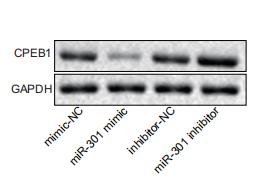| 产品: | CPEB1 抗体 |
| 货号: | DF2462 |
| 描述: | Rabbit polyclonal antibody to CPEB1 |
| 应用: | WB IF/ICC |
| 文献验证: | WB |
| 反应: | Human, Mouse, Rat |
| 预测: | Pig, Zebrafish, Horse, Sheep, Rabbit, Dog, Chicken, Xenopus |
| 分子量: | 63 kDa; 63kD(Calculated). |
| 蛋白号: | Q9BZB8 |
| RRID: | AB_2839668 |
产品描述
*The optimal dilutions should be determined by the end user.
*Tips:
WB: 适用于变性蛋白样本的免疫印迹检测. IHC: 适用于组织样本的石蜡(IHC-p)或冰冻(IHC-f)切片样本的免疫组化/荧光检测. IF/ICC: 适用于细胞样本的荧光检测. ELISA(peptide): 适用于抗原肽的ELISA检测.
引用格式: Affinity Biosciences Cat# DF2462, RRID:AB_2839668.
展开/折叠
CEBP; CPE binding protein 1; CPE BP1; CPE-binding protein 1; CPE-BP1; CPEB 1; CPEB; CPEB-1; CPEB1; CPEB1 protein; CPEB1_HUMAN; Cytoplasmic polyadenylation binding protein 1; Cytoplasmic polyadenylation element binding protein; Cytoplasmic polyadenylation element binding protein 1; Cytoplasmic polyadenylation element-binding protein 1; FLJ13203; h CEBP; h-CEBP; hCPEB 1; hCPEB-1; MGC34136; MGC60106; mKIAA0940; MKIAA0940 protein;
抗原和靶标
Isoform 1 is expressed in immature oocytes, ovary, brain and heart. Isoform 2 is expressed in brain and heart. Isoform 3 and isoform 4 are expressed in brain. Expressed in breast tumors and several tumor cell lines.
- Q9BZB8 CPEB1_HUMAN:
- Protein BLAST With
- NCBI/
- ExPASy/
- Uniprot
MALSLEEEAGRIKDCWDNQEAPALSTCSNANIFRRINAILDNSLDFSRVCTTPINRGIHDHLPDFQDSEETVTSRMLFPTSAQESSRGLPDANDLCLGLQSLSLTGWDRPWSTQDSDSSAQSSTHSVLSMLHNPLGNVLGKPPLSFLPLDPLGSDLVDKFPAPSVRGSRLDTRPILDSRSSSPSDSDTSGFSSGSDHLSDLISSLRISPPLPFLSLSGGGPRDPLKMGVGSRMDQEQAALAAVTPSPTSASKRWPGASVWPSWDLLEAPKDPFSIEREARLHRQAAAVNEATCTWSGQLPPRNYKNPIYSCKVFLGGVPWDITEAGLVNTFRVFGSLSVEWPGKDGKHPRCPPKGNMPKGYVYLVFELEKSVRSLLQACSHDPLSPDGLSEYYFKMSSRRMRCKEVQVIPWVLADSNFVRSPSQRLDPSRTVFVGALHGMLNAEALAAILNDLFGGVVYAGIDTDKHKYPIGSGRVTFNNQRSYLKAVSAAFVEIKTTKFTKKVQIDPYLEDSLCHICSSQPGPFFCRDQVCFKYFCRSCWHWRHSMEGLRHHSPLMRNQKNRDSS
种属预测
score>80的预测可信度较高,可尝试用于WB检测。*预测模型主要基于免疫原序列比对,结果仅作参考,不作为质保凭据。
High(score>80) Medium(80>score>50) Low(score<50) No confidence
研究背景
Sequence-specific RNA-binding protein that regulates mRNA cytoplasmic polyadenylation and translation initiation during oocyte maturation, early development and at postsynapse sites of neurons. Binds to the cytoplasmic polyadenylation element (CPE), an uridine-rich sequence element (consensus sequence 5'-UUUUUAU-3') within the mRNA 3'-UTR. RNA binding results in a clear conformational change analogous to the Venus fly trap mechanism. In absence of phosphorylation and in association with TACC3 is also involved as a repressor of translation of CPE-containing mRNA; a repression that is relieved by phosphorylation or degradation (By similarity). Involved in the transport of CPE-containing mRNA to dendrites; those mRNAs may be transported to dendrites in a translationally dormant form and translationally activated at synapses (By similarity). Its interaction with APLP1 promotes local CPE-containing mRNA polyadenylation and translation activation (By similarity). Induces the assembly of stress granules in the absence of stress. Required for cell cycle progression, specifically for prophase entry.
Phosphorylated on serine/threonine residues by AURKA within positions 166 and 197. Phosphorylation and dephosphorylation on Thr-172 regulates cytoplasmic polyadenylation and translation of CPE-containing mRNAs. Phosphorylation on Thr-172 by AURKA and CAMK2A activates CPEB1. Phosphorylation on Thr-172 may be promoted by APLP1. Phosphorylation increases binding to RNA (By similarity).
Cytoplasm. Nucleus. Cytoplasm>P-body. Cytoplasmic granule. Cell junction>Synapse. Membrane. Cell junction>Synapse>Postsynaptic density. Cell projection>Dendrite.
Note: Continuously shuttling between nucleus and cytoplasm (PubMed:18923137). Also found in stress granules. Recruited to stress granules (SGs) upon arsenite treatment. In dendrites (By similarity). Localizes in synaptosomes at dendritic synapses of neurons (By similarity). Strongly enriched in postsynaptic density (PSD) fractions (By similarity). Transported into dendrites in a microtubule-dependent fashion and colocalizes in mRNA-containing particles with TACC3, dynein and kinesin (By similarity). Membrane-associated (By similarity). Colocalizes at excitatory synapses with members of the polyadenylation and translation complex factors (CPSF, APLP1, TACC3, AURKA, SYP, etc.) including CPE-containing RNAs (By similarity).
Isoform 1 is expressed in immature oocytes, ovary, brain and heart. Isoform 2 is expressed in brain and heart. Isoform 3 and isoform 4 are expressed in brain. Expressed in breast tumors and several tumor cell lines.
Interacts with kinesin, dynein, APLP1, APLP2, TENT2/GLD2 and APP. Both phosphorylated and non phosphorylated forms interact with APLP1 (By similarity). Interacts with TENT4B; the interaction is required for TENT4B-mediated translational control.
The 2 RRM domains and the C-terminal region mediate interaction with CPE-containing RNA (PubMed:24990967). The interdomain linker (411-429) acts as a hinge to fix the relative orientation of the 2 RRMs (PubMed:24990967). The ZZ domain (509-566) coordinates 2 Zn ions and is probably implicated in mediating interactions with other proteins in addition to increasing the affinity of the RRMs for the CPEs (PubMed:23500490, PubMed:24990967). A continuous hydrophobic interface is formed between the 2 RRMs (PubMed:24990967).
Belongs to the RRM CPEB family.
研究领域
· Cellular Processes > Cell growth and death > Oocyte meiosis. (View pathway)
· Organismal Systems > Endocrine system > Progesterone-mediated oocyte maturation.
文献引用
Application: WB Species: Human Sample: breast cancer cells
限制条款
产品的规格、报价、验证数据请以官网为准,官网链接:www.affbiotech.com | www.affbiotech.cn(简体中文)| www.affbiotech.jp(日本語)产品的数据信息为Affinity所有,未经授权不得收集Affinity官网数据或资料用于商业用途,对抄袭产品数据的行为我们将保留诉诸法律的权利。
产品相关数据会因产品批次、产品检测情况随时调整,如您已订购该产品,请以订购时随货说明书为准,否则请以官网内容为准,官网内容有改动时恕不另行通知。
Affinity保证所销售产品均经过严格质量检测。如您购买的商品在规定时间内出现问题需要售后时,请您在Affinity官方渠道提交售后申请。产品仅供科学研究使用。不用于诊断和治疗。
产品未经授权不得转售。
Affinity Biosciences将不会对在使用我们的产品时可能发生的专利侵权或其他侵权行为负责。Affinity Biosciences, Affinity Biosciences标志和所有其他商标所有权归Affinity Biosciences LTD.


